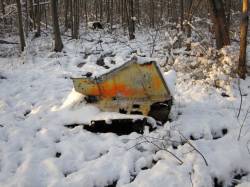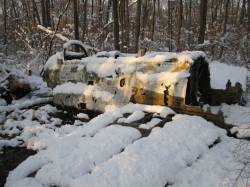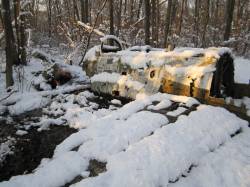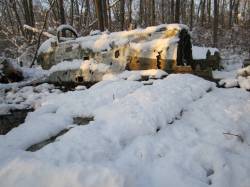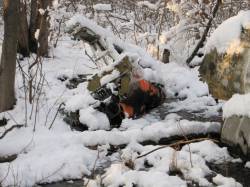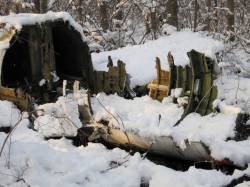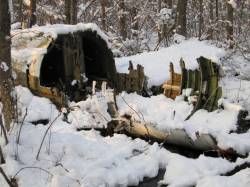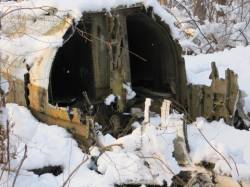One of my other hobbies aside from flying is hiking. In particular geocaching. I was recently looking for more caches in the area of West Milford, NJ and came across something I couldn’t resist. It is an old military jet that crashed in the woods more then 40 years ago. One minor problem was the fact that it had snowed the night before so the wreck slightly covered. The cold weather did help getting to the site. It is a very very swampy area and most of the ground was hard and easily walkable.
The Lockheed T2V SeaStar, later called the T-1 SeaStar, was a turbojet trainer aircraft for the U.S. Navy that entered service in May 1957. It was developed from the Lockheed T-33 and powered by one Allison J33 engine. Wikipedia
It was difficult finding a reliable source for the actual history of this wreck. What I have disseminated from a few sites is that the crash was part of a training exercise in 1967 and the pilot survived the crash. Here is some info from another site:
The pilot lived, he actually flew the plane in, from South to North, it is now oriented facing Westerly……A woman in the area, who’s boyfriend at the time was a Police Officer, heard the crash, called Police Officer boyfriend, he hiked in to the site and found the pilot sitting on the wing pretty dazed, but alive…… Now as to the direction of the wreckage… the plane came in from South to North, but the wreckage lies West to East, this is because of when the engine was lifted out by helicopter, there was some entanglement and the entire craft lifted and spun before the engine pulled free of airframe. The orange paint is to mark it as found wreckage of a know crash, to help reduce reports of a sighted crash by other pilots, hikers etc…The engine was airlifted to Greenwood Lake Airport so it could be taken by larger plane to wherever they would take salvage parts, and the helicopter almost crashed from the weight and instablity of the engine load (just a side note). (waymarking)
Update: 5/2017 – I received this comment from a former T2V pilot. Great information regarding this type and this incident. Thank you Tor.
That a/c was indeed a T2V-1 (since it crashed-landed several months before the re-designation to T-1A became official). There has been so much scuttlebutt about this wreck, much of which has been based on “completely wrong guesses” . . .
This one was assigned since 1960 to NAS New York (Floyd Bennett Field) with the BuNo of 142540 – and was aka 7R-540.
Prior to 1960 it was attached to BTG-9 as 2F-XXX
[It can be seen in a photo, second from the bottom of pg 48 in Steve Ginter’s book: “Lockheed T2V-1/T-1A Seastar”- #42 in his Naval Fighter Series]
It was a “Base Flight” plane, and was used as a “flight-time builder” for active duty and (NARTU) Navy/Marine reserve pilots striving to “keep current” in jets.
On 15 July 1962, 7R-540 was on a routine training flight when it flamed out. Fuel starvation was the probable culprit . . . That a/c type was notoriously short legged.
The pilot was apparently unable to activate the ejection seat, so the plane was “dead-sticked” down to the ground near West Milford, NJ.
It was fortunate and unusual that there were no serious injuries/fatalities in this incident, since the T2V-1/T1A possessed the glide rate of a common brick.
I logged a few hours in [at least] 2 T2V-1s, during flight training in NAS Pensacola, about that same time (BuNos 144204 and 144758 in Jul, Aug 1962).
Hope this helps a bit,
Tor Welch


